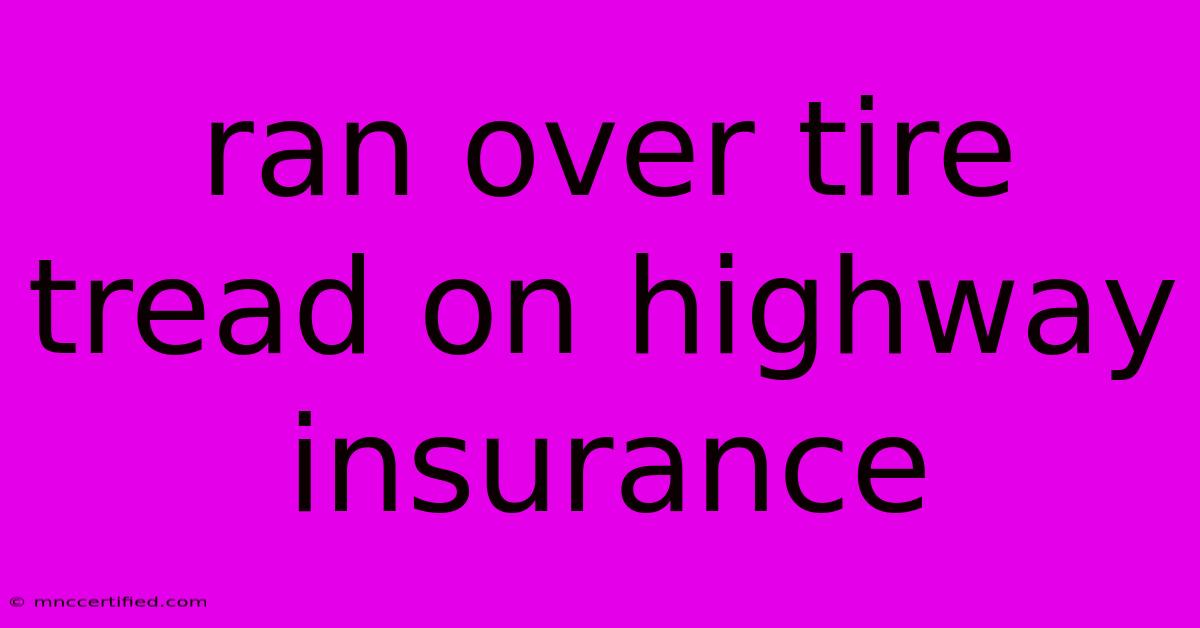Ran Over Tire Tread On Highway Insurance

Table of Contents
Hit a Tire Tread on the Highway? Here's What to Do and How Insurance Can Help
Driving on a highway can be risky, and sometimes even the most careful drivers encounter unexpected hazards. One such hazard is tire tread that can be thrown onto the road by passing vehicles. If you've hit a tire tread on the highway, you're likely wondering about the next steps and how your insurance might cover the damages. This article will guide you through the process of handling this unfortunate situation, from the immediate steps to your insurance claim.
What to Do After Hitting a Tire Tread
- Safety First: Pull over to a safe location as soon as possible. Ensure your vehicle is off the road and away from traffic. Turn on your hazard lights to alert other drivers.
- Assess the Damage: Check for any visible damage to your vehicle. Look for punctures, scratches, or dents. If you suspect damage to your tires, avoid driving further.
- Call for Help: Contact your roadside assistance service or a towing company if needed. You may also want to contact the police to report the incident, especially if the damage is significant.
- Document Everything: Take pictures of the damage to your vehicle and the tire tread. If possible, try to collect the tire tread itself.
- Get Witness Information: If anyone saw the incident, try to obtain their contact information.
Understanding Your Insurance Coverage
Most auto insurance policies cover damage caused by road debris like tire treads. However, the extent of coverage varies depending on your policy. It's crucial to review your policy documents to understand your specific coverage and deductibles. Here's a breakdown of common coverage options:
- Collision Coverage: This covers damage to your vehicle caused by collisions with other objects, including tire treads. You'll likely have to pay your deductible before your insurance covers the remaining costs.
- Comprehensive Coverage: This covers damage to your vehicle caused by events other than collisions, such as theft, vandalism, or natural disasters. Some comprehensive policies may cover road debris damage.
- Uninsured/Underinsured Motorist Coverage: This coverage protects you if you are hit by a driver who is uninsured or underinsured. It may apply in cases where the tire tread originated from a vehicle that was not properly maintained.
Filing Your Insurance Claim
Once you've assessed the damage and contacted your insurance company, you'll need to file a claim. Here's what you'll need to do:
- Contact your insurance company: Call your insurance provider and report the incident. Be prepared to provide details about the incident, location, time, and any other relevant information.
- Complete a claim form: You'll need to provide detailed information about the damage to your vehicle, including photos and a description of the incident.
- Provide any supporting documentation: This may include police reports, witness statements, and any other relevant documentation.
Tips for a Smooth Claim Process
- Be honest and accurate: Provide truthful information to your insurance company.
- Keep all documentation organized: Organize all relevant documents, including photos, repair estimates, and any other supporting evidence.
- Be patient: The insurance claim process can take time, so be patient and follow up with your insurer if you have any questions.
Preventing Tire Tread Hazards
While you can't always prevent tire tread from being thrown onto the road, you can take steps to minimize the risk of hitting it:
- Maintain your tires: Regularly check your tire pressure and tread depth. Worn tires are more likely to lose tread.
- Drive defensively: Pay attention to your surroundings and be aware of other vehicles on the road.
- Avoid sudden lane changes: Sudden maneuvers can increase the risk of encountering road debris.
Remember: While hitting a tire tread is an unfortunate incident, it's important to remain calm, assess the situation, and take the necessary steps to protect yourself and your vehicle. By understanding your insurance coverage and following the appropriate procedures, you can navigate this situation smoothly and get your vehicle back on the road.

Thank you for visiting our website wich cover about Ran Over Tire Tread On Highway Insurance. We hope the information provided has been useful to you. Feel free to contact us if you have any questions or need further assistance. See you next time and dont miss to bookmark.
Featured Posts
-
Whats Next For Shetland Jensens Update
Nov 08, 2024
-
Jimmy Kimmels Trump Win Monologue
Nov 08, 2024
-
Robins Exits Coventry After Long Tenure
Nov 08, 2024
-
Automatic Premium Loan On Life Insurance
Nov 08, 2024
-
Special Needs Wagon Covered By Insurance
Nov 08, 2024